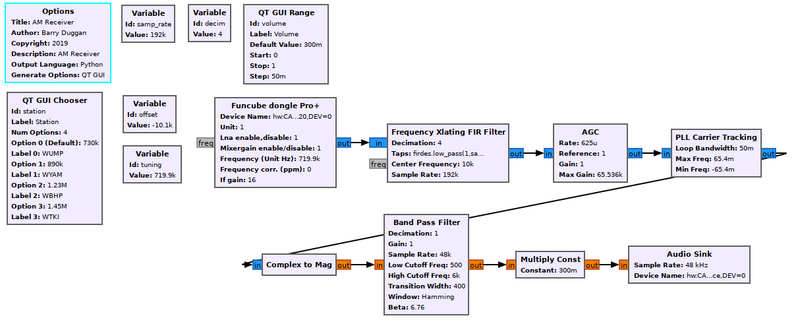PLL Carrier Tracking: Difference between revisions
Jump to navigation
Jump to search
No edit summary |
(→Notes) |
||
| (5 intermediate revisions by one other user not shown) | |||
| Line 1: | Line 1: | ||
[[Category:Block Docs]] | [[Category:Block Docs]] | ||
Implements a PLL which locks to the input frequency and outputs the input signal mixed with that carrier. | Implements a Phase Locked Loop (PLL) which locks to the carrier of the input frequency and outputs the input signal mixed with that carrier. | ||
This PLL locks onto a [possibly noisy] reference carrier on the input and outputs that signal, downconverted to DC | This PLL locks onto a [possibly noisy] reference carrier on the input and outputs that signal, downconverted to DC. | ||
=== Notes === | |||
* <b>Important:</b> The frequency parameters below are in <i>radians per sample</i> rather than Hz.<br> | |||
<pre>radians per sample = 2 * pi * centerfreq / sample rate</pre> | |||
* Example: | |||
** input signal, centered at 0Hz, centerfreq = 0 Hz. | |||
** Sample rate = 48kHz. | |||
** frequency variations to track +- 500Hz. | |||
** Max Phase/sample = 2*pi*(0+500)/48,000 = 0.0654 | |||
** Min Phase/sample = 2*pi*(0-500)/48,000 = -0.0654 | |||
* If the input signal were centered at 10kHz, | |||
** Then: | |||
** The Max Phase/sample = 2*pi*(10,000+500)/48,000 = 1.374 | |||
** The Min Phase/sample = 2*pi*(10,000-500)/48,000 = 1.246 | |||
* This block seems to require an input signal of at least -30db in order to lock to the carrier. | |||
== Parameters == | == Parameters == | ||
| Line 8: | Line 25: | ||
; Loop bandwidth (''R'') | ; Loop bandwidth (''R'') | ||
: The loop bandwidth determines the lock range and should be set | : The loop bandwidth determines the lock range and should be set in the range of pi/200 to 2pi/100 (0.0157 to 0.0628). | ||
; Max freq | ; Max freq | ||
: Maximum frequency of the carrier in radians per sample | : Maximum frequency of the carrier in <i>radians per sample</i>. See Notes above. | ||
; Min freq | ; Min freq | ||
: Minimum frequency of the carrier in radians per sample | : Minimum frequency of the carrier in <i>radians per sample</i>. See Notes above. | ||
== Example Flowgraph == | == Example Flowgraph == | ||
This flowgraph shows the use of a PLL Carrier Tracking block in an AM receiver. | |||
[[File:Complex_to_Mag.png|800px]] | |||
== Source Files == | == Source Files == | ||
Latest revision as of 11:17, 1 June 2023
Implements a Phase Locked Loop (PLL) which locks to the carrier of the input frequency and outputs the input signal mixed with that carrier.
This PLL locks onto a [possibly noisy] reference carrier on the input and outputs that signal, downconverted to DC.
Notes
- Important: The frequency parameters below are in radians per sample rather than Hz.
radians per sample = 2 * pi * centerfreq / sample rate
- Example:
- input signal, centered at 0Hz, centerfreq = 0 Hz.
- Sample rate = 48kHz.
- frequency variations to track +- 500Hz.
- Max Phase/sample = 2*pi*(0+500)/48,000 = 0.0654
- Min Phase/sample = 2*pi*(0-500)/48,000 = -0.0654
- If the input signal were centered at 10kHz,
- Then:
- The Max Phase/sample = 2*pi*(10,000+500)/48,000 = 1.374
- The Min Phase/sample = 2*pi*(10,000-500)/48,000 = 1.246
- This block seems to require an input signal of at least -30db in order to lock to the carrier.
Parameters
(R): Run-time adjustable
- Loop bandwidth (R)
- The loop bandwidth determines the lock range and should be set in the range of pi/200 to 2pi/100 (0.0157 to 0.0628).
- Max freq
- Maximum frequency of the carrier in radians per sample. See Notes above.
- Min freq
- Minimum frequency of the carrier in radians per sample. See Notes above.
Example Flowgraph
This flowgraph shows the use of a PLL Carrier Tracking block in an AM receiver.
Source Files
- C++ files
- TODO
- Header files
- TODO
- Public header files
- TODO
- Block definition
- TODO
